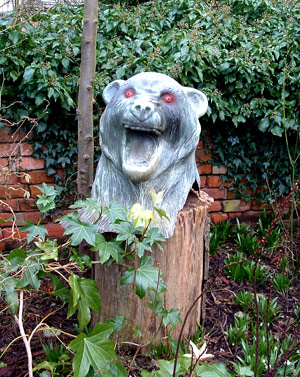Using salvage in the garden - 15 ideas for using 'junk'
If you have what at first sight seems like old junk about your home (and who doesn't?) don't throw it out without stopping to think for a moment. Objects that initially look as if they should go straight to the recycling centre can be salvaged to make interesting planting ideas, as well as adding unique style to your garden.
After a few seasons of burnished metal being fashionable, rusty iron is popular this year for adding as decoration around the garden, as are logs and building materials such as terracotta piping and bricks.
Here are 15 ideas to help you think about how you can use some of the 'junk' that you've got stashed away to add interest and style to your garden, much of it without even having to step outside your gate.
This modern shed is right outside a kitchen window, which may not be the ideal spot for it, but if you haven't got anywhere else for it to stand, then needs must.
It doesn't have to look quite so plain, though; here, the shed has been decorated with old riddles which have had rusty old gardening tools wired on to them, making the whole structure much more attractive.
In addition, the rose which has been planted nearby will soon soften the edges of the wood and the roof.
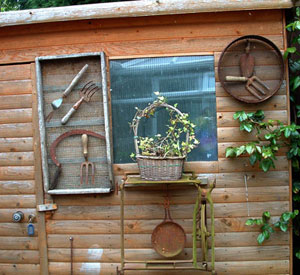
There aren't that many sewing machine stands about these days, but they can still be found in a few sheds and garages, as well as second hand shops. Rather than leaving them to gather dust, use them as small display tables for plant containers or collections of interesting stones.
This table has lost its top, so someone has used a found slab of stone instead, which supports a trough of flowering plants. If you don't have a slab of stone, a couple of sections of weathered scaffolding board would work just as well.
Displays like this can brighten up gloomy corners and also serve to take attention away from less attractive structures. Here, the table is hiding the entrance to the space for the household oil tank. Since access is only needed once or twice a year, it isn't an obstruction.
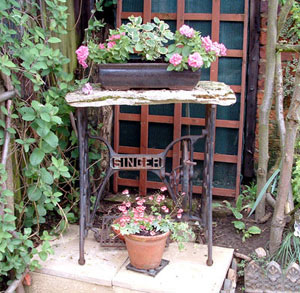
This sewing machine table is being used to display old weights and a set of scales, while old-fashioned pots are clustered at the bottom.
Against the backing of the red brick wall, ivy and peeling whitewash, it adds interest to an otherwise rather dull corner.
If there isn't enough light to grow colourful plants then displaying such oddments instead can look very attractive.
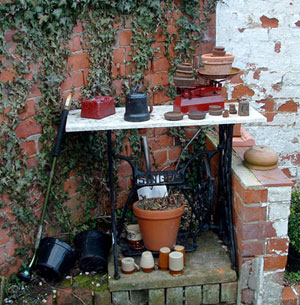
Odd bits of stone can be used to create a very attractive mini rock garden. I saw this little display at RHS Harlow Carr, near Harrogate in Yorkshire.
Here, Androsace carnea has been used; the plants will gradually spread to form rounded mounds. Sempervivums would also look good or, if you want something quick to fill in for this summer, you could try planting plugs of Lobularia maritima (Sweet Alyssum), which will give off a beautiful honey-like scent from clusters of tiny pink or white flowers.
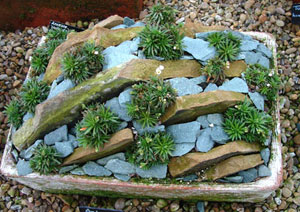
A section of plumbing pipe can make an unusual plant container. This one was seen at Harlow Carr, in Yorkshire.
If you want to plant a pipe like this with annuals, soak it in water for an hour first to stop it drying out so quickly. It will also need regular watering in hot weather.
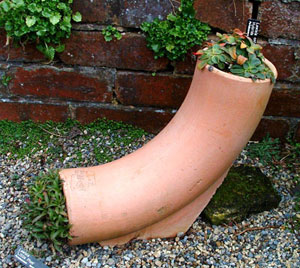
Even modern bricks can be put to use. Bricks with holes can be used for planting succulents such as Sempervivums.
The brick holes, filled with compost and grit, will give the plants the sharp drainage they need to thrive.
Once the plants mature a bit, they'll fill the holes and start to spread over the brick surface.
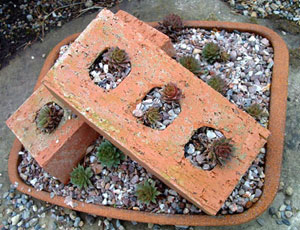
Leave porous objects (e.g. bricks or terracotta objects) outside for a couple of seasons and colourful algae may well start to establish.
To speed up the aging of such objects, they can be sprayed with milk or painted with yoghurt. After a few weeks, algae will start to form on the surface. To start with, it will be green but if you wait other, larger, algae will grow.
If you decide to use yoghurt on pots that are at ground level, and you have a dog, lift the pots up out of reach till the yoghurt has dried or, as fast as you paint it on, the dog will follow you round and lick it all off again. Your dog will probably give you very strange looks as well.

Here, an old work boot has been used as a plant container. The old leather has weathered and now supports mosses as well as the plant. Standing in a corner of some brick steps it's quirky and eye-catching.
You could also plant it up with a trailing annual like lobelia or the cheerful yellow-flowered Bidens 'Gold Spark'.

An old wheel leans against a wood pile at the edge of a pond. Items like this can be found at salvage yards or sometimes via demolition companies.
It isn't just ornamental either - the wheel will eventually provide support for plants; it will also be used for birds who have just bathed and want somewhere to sit and groom their feathers before flying away.
The logs will give shelter to frogs and toads during the heat of the day, whilst the inner wood will make a habitat for ground beetle larvae, which will grow into valuable helpers around the garden. Ground beetles are very fond of vine weevils and will help protect your plants. Larger beetles will eat slugs and snails.

If we hadn't stopped to think about it, we'd have taken this broken old fire grate to the tip. It sat outside by the shed for a few weeks and, as you do, we forgot about it for a while.
Once the soot had washed away, and the iron started to rust, different colours began to appear and it occurred to me that it could be used as a plant stand.
Supporting a pot of red geraniums, and a few greened-up old pots, it has a certain rustic charm.
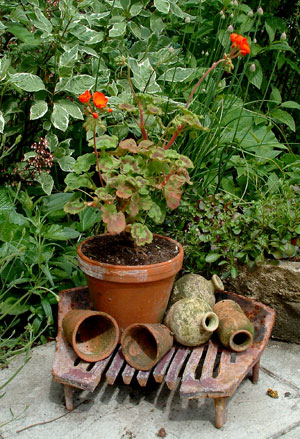
This is all that remains of a particularly thuggish shrub. Once the branches had been cut away, the stump was drilled with large holes. When it's weathered a bit, they can be planted with tiny succulents or left for mosses to grow.
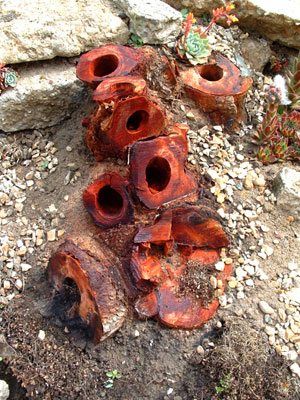
A hollowed out old log has been turned into part of a small water feature. It sits in a container of water, bordered by old tiles and backed by ferns.
Make a feature like this to add both sound and visual interest to a damp and shady corner. Add a couple of small lamps for the evenings and it will become quite atmospheric, even magical.
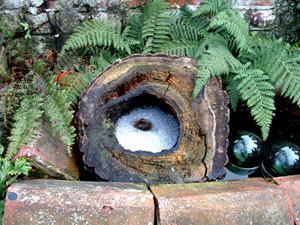
If you have some old bits of branch, tree or shrub roots, you can fill the gaps in the wood with soil and then put in drought tolerant plants like the trailing Sedum 'Ruby Glow' shown here. Add Mediterranean herbs and you'll have fresh herbs for the kitchen as well as an attractive display.
Use an arrangement like this to add interest to a gravel garden, or rockery, which gets plenty of sun.
In areas that get less light, use shade loving plants like ferns. In shady areas, you may also get some interesting mosses growing on the wood.
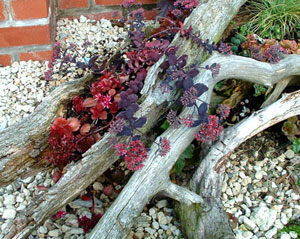
If you have a lot of tall prunings, save them to make a wigwam type support for sweet peas or climbing beans.
The wigwam shown here was seen at Normanby Hall walled garden, near Scunthorpe, in North Lincolnshire.
Clumps of sweet peas have been planted around the base and will soon cover the structure with foliage and scented flowers.
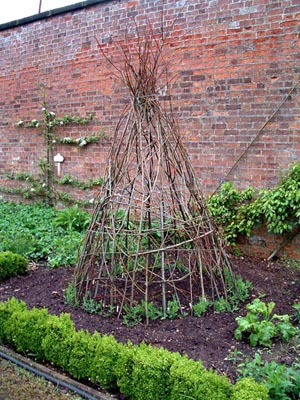
Finally, even the most unexpected objects can be used to surprise your guests. This fearsome bear's head is made of plastic and sits on an old tree stump tucked into the corner of a garden.
Now that you have a few suggestions for recycling some of those things you didn't know what to do with, you can make a unique and eye-catching display for your garden.
You'll also have the comfortable knowledge that you might not have had to pay for it, and that no-one else has the same.
Using recycled objects in the garden isn't just about being trendy, it also shows that you're caring for the environment by not thoughtlessly throwing things away. Many of the things you use will also help to provide habitats for wildlife, such as amphibians and endangered ground beetles.
